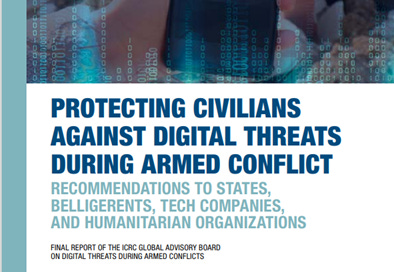Today, a high-level group of experts issued key recs. on protecting civilians against digital threats during armed conflict
What’s so special about this group and their report is that it brought together high-level experts from the tech, military, legal and policy fields from all continents and contains recommendations on cyber, mis/disinformation, digital threats to humanitarian organizations, and the worrying trend of civilian being drawn into digital military operations. There report is here, but I thought it’d be helpful to provide some background information from the International Committee of the Red Cross (ICRC) about this group:
Between 2021-2023, the ICRC’s President convened a high-level advisory board (“ICRC Global Advisory Board”) to advise the organization and develop concrete recommendations on the legal and policy challenges to protect civilians from cyber threats and other digital risks during armed conflict. The Board consisted of a diverse group of non-governmental leaders and experts from the legal, military (former cyber commanders), policy (former ministers, policy leaders), technological (major tech companies), and civil society (UN, academia) from all parts of the world.
What was the objective of convening the Board? The ICRC convened the Board to seek the advice of multidisciplinary leaders from all parts of the world on how to protect civilians against digital threats and how to position our organization on such matters. The ICRC also worked with the Board to produce a joint report with concrete recommendations to belligerents (i.e. state and non-state parties to a conflict), states, tech companies, and humanitarian organizations on protecting civilians against digital threats.
What issues did the Board look at? The board looked at key issues regarding the protection of civilians against digitalizing armed conflicts. This included, in particular, cyber operations, information operations (which is part of the ICRC’s work on MDH), digital threats to humanitarian organizations, and the risks that arise when civilians are drawn into digital military operations. On each of these issues, the Board help the ICRC to understand threats and risks and provided recommendations on how to address them.
What does the report contain? At the heart of the report are 25 action-oriented recommendations: 6 to Belligerents to ensure respect for international law and restraint in military operations ; 8 to States to build resilience against threats and enhance respect for international law; 4 to Tech Companies to prevent abuse of their platforms and take steps to prevent harm to civilians; 4 to Humanitarian Organizations to build resilience against threats to their operations and protect civilians; and 3 on working together with a view to safeguard civilians against digital threats.
The Board also flags four worrying trends for civilians in digitalizing armed conflicts: Cyber operations disrupting of essential civilian infrastructure, services, and data; Harmful information spreading with unprecedented scale, speed, and reach; a blurring of the line between what is civilian and what is military; threats to humanitarian organizations.
The report also contains four overarching principles that guided the Board’s work: Digital space is not lawless, including during armed conflict; Protecting civilians from digital threats requires investment in legislation, policies, and procedures; Political and military leaders should focus on protecting civilians; Joint investment is needed to use digital technology to enhance the protection of civilians.
What does the ICRC aim to achieve with the report? In the ICRC’s view, the Board presents some of the most acute digital threats to civilians during armed conflict and concrete, multidisciplinary recommendations to address these. The ICRC hopes that the report and recommendations will trigger conversations, reflection and action to protect civilians against digital threats during armed conflicts.
For instance, and among other, the ICRC would like to see States working across regional and multilateral fora to build a common understanding of how international humanitarian law protects civilians against digital threat; States – with tech companies and civil society – seeking conversations on the risk of blurring lines between civilian and military spaces in the digital environment; the inclusion of a ‘digital dimension’ in regional and multilateral work and resolutions on humanitarian activities.




